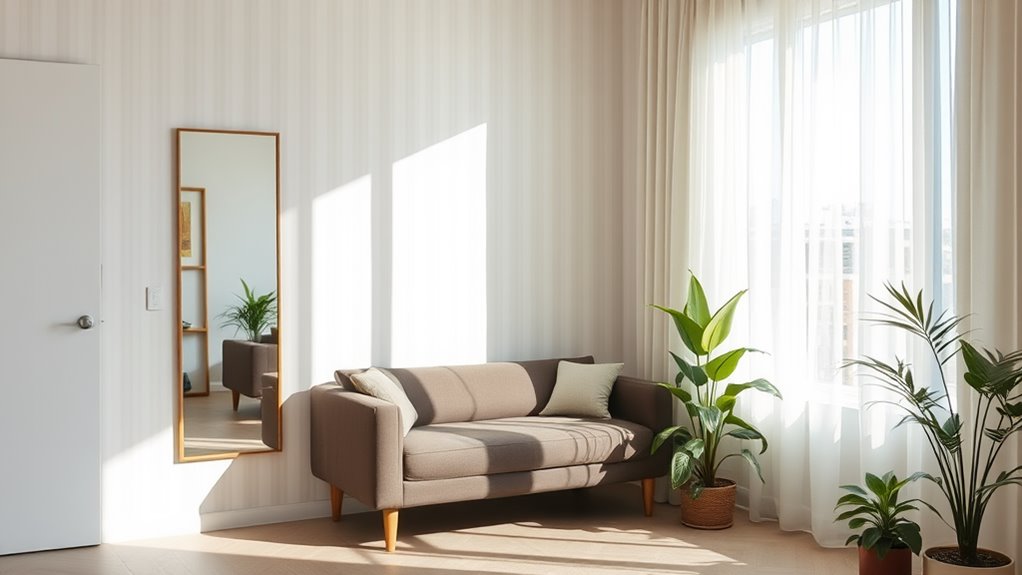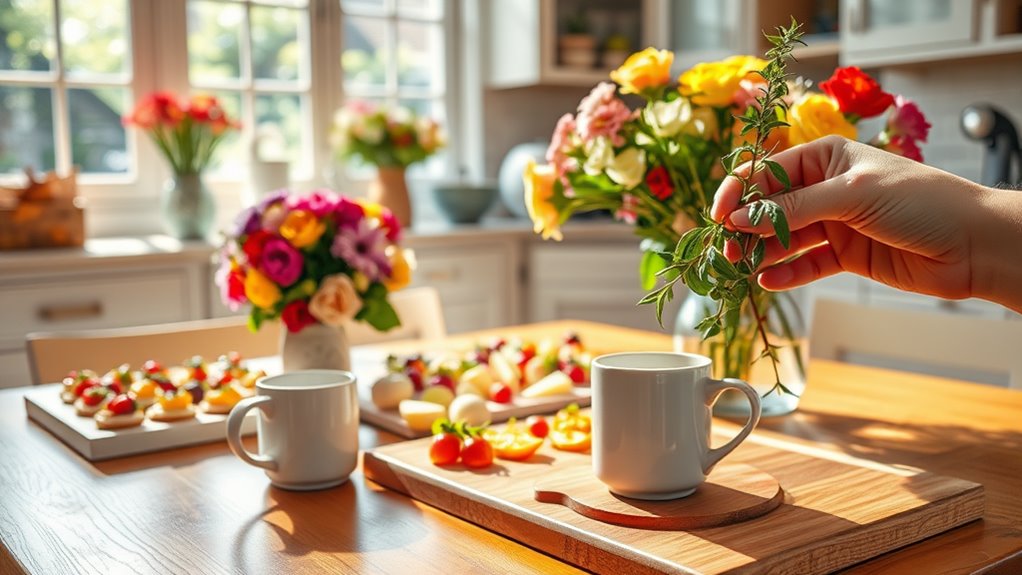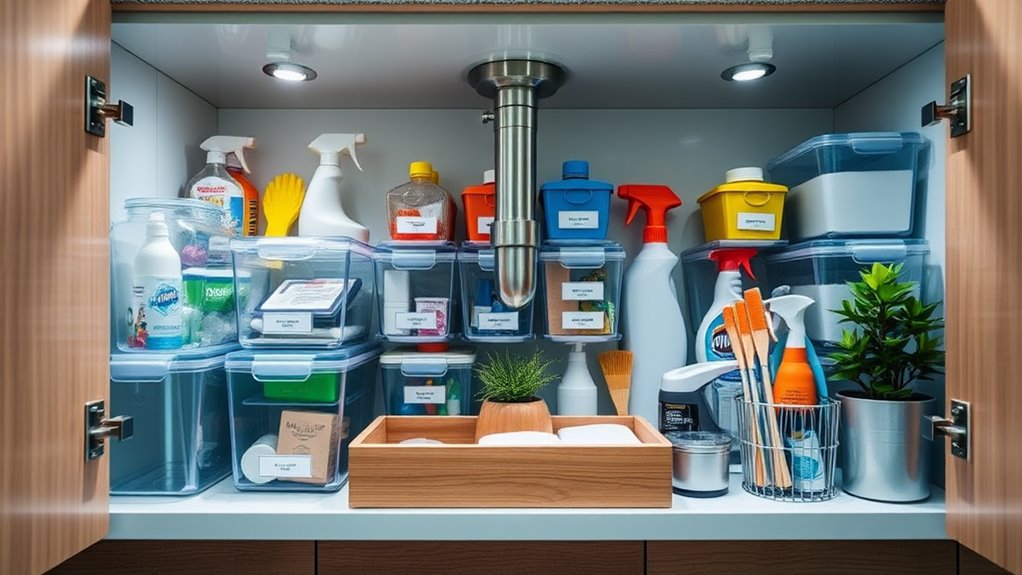My Go-To Tricks for Making Small Spaces Feel Huge
To make small spaces feel huge, embrace light colors that reflect natural light, and optimize vertical space with tall shelving and wall-mounted storage. Use multi-functional furniture, like storage ottomans and convertible sofas, to maximize usability. Incorporate mirrors to enhance depth and openness, while keeping areas clutter-free for a clean look. Create defined zones with area rugs, hang curtains high, and add strategic artwork for visual interest. Discover additional tips to revealing your space’s potential.
Key Takeaways
- Embrace light colors like soft whites and pastels to reflect natural light and create an airy atmosphere.
- Utilize vertical storage solutions and tall shelving to draw the eye upward and maximize space.
- Incorporate multi-functional furniture, such as storage ottomans and convertible sofas, to save space and enhance usability.
- Keep the space clutter-free by regularly organizing and using area rugs to define separate zones.
- Use mirrors to create depth and amplify light, enhancing the perception of openness in small spaces.
Embrace Light Colors
When you embrace light colors, you instantly transform a cramped space into a more open and welcoming environment. These hues reflect natural light, creating an illusion of depth that tricks the eye. Opt for soft whites, pale blues, or gentle pastels—these shades expand your space visually.
Pairing these colors with strategically placed mirrors amplifies this effect, enhancing brightness and spaciousness. Consider your furniture too; selecting lighter pieces complements your color palette and keeps the atmosphere airy. Additionally, using optical illusions through design techniques can further enhance the perception of space in your room.
Optimize Vertical Space
To make your small space feel larger, think vertical.
Tall shelving units and wall-mounted storage solutions can draw the eye upward, maximizing every inch. Adding hanging decor elements not only saves floor space but also adds personality to your walls. Incorporating vertical storage solutions can significantly enhance the functionality of your space while maintaining an open feel. Additionally, using functional storage methods can help ensure that each item has its place, contributing to a more organized and spacious atmosphere. Consider utilizing multi-functional furniture that can serve dual purposes, further optimizing your space and providing additional storage options. Implementing affordable organization solutions can also transform cluttered areas into efficient storage systems. One effective strategy is to use smart organization techniques, as they can help you create a more visually spacious environment.
Tall Shelving Units
Tall shelving units are a game-changer for maximizing vertical space in small rooms. By reaching for the sky, these versatile pieces draw the eye upward, creating an illusion of spaciousness.
Choose units that fit snugly against walls, allowing for strategic placement in corners or narrow areas. Fill them with a mix of books, decorative items, and plants to maintain visual interest while avoiding clutter.
Remember to keep the heavier items at the bottom for stability, and vary the heights of your decor to add dimension. You can also incorporate baskets or boxes to store smaller items, keeping everything organized.
With tall shelving units, you don’t just save space; you elevate your room’s style and functionality.
Wall-Mounted Storage Solutions
Although small spaces can feel limiting, wall-mounted storage solutions can transform your room by maximizing vertical space. By utilizing the walls, you not only declutter but also create a visually appealing environment.
Here are some effective options to contemplate:
-
Floating Shelves: These provide stylish storage without taking up floor space.
-
Pegboards: Ideal for organizing tools or craft supplies, they offer versatility and easy access.
-
Wall-Mounted Baskets: Perfect for holding everything from magazines to plants, adding texture and charm.
Incorporating these elements will elevate your space, making it feel larger and more organized.
Embrace the power of vertical storage, and watch your small area flourish!
Hanging Decor Elements
Incorporating hanging decor elements can instantly elevate your small space while optimizing vertical areas. Think beyond traditional frames; consider macramé plant hangers, floating shelves, or wall-mounted art.
These elements draw the eye upward, creating an illusion of height and spaciousness. You can also use a series of hooks to display hats or art pieces, transforming functional storage into aesthetic statements.
For added depth, layer different textures and materials—mix woven baskets with sleek metal accents. Remember to maintain balance; too much clutter can overwhelm.
Strategically placing these elements not only showcases your personality but also makes your space feel more open and inviting. Embrace your walls as a canvas, and let your creativity soar!
Use Multi-Functional Furniture
When you’re working with limited square footage, choosing multi-functional furniture can transform your space dramatically.
These versatile pieces not only save room but also add style. By integrating furniture that serves multiple purposes, you can maximize both functionality and aesthetics.
Consider these options:
-
Storage ottomans: Use them as seating, footrests, or hidden storage for blankets and magazines.
-
Murphy beds: Fold them up during the day for more living space, then pull them down for a cozy night’s sleep.
-
Convertible sofas: These can transform from a stylish couch to a bed, perfect for hosting guests without sacrificing space.
Selecting the right multi-functional furniture elevates your small space, creating an open and inviting atmosphere.
Incorporate Mirrors
Mirrors can work wonders in small spaces by creating the illusion of depth and openness.
When you strategically place them, they can reflect light and views, making your area feel larger.
Let’s explore how you can use reflective surfaces to enhance your space effectively.
Reflective Surfaces Expand Space
Using reflective surfaces can instantly transform your small space, making it feel more expansive and open.
Mirrors are your best allies in this endeavor. They not only bounce light around the room but also create the illusion of depth.
Here are a few ways to effectively use reflective surfaces:
-
Large Mirrors: Opt for oversized mirrors to amplify the feeling of space dramatically.
-
Mirrored Furniture: Incorporate pieces like coffee tables or cabinets with mirrored surfaces to add a touch of elegance while reflecting surroundings.
-
Glass Accents: Use glass decor items to enhance the light flow and create a seamless, airy atmosphere.
Strategic Placement Matters
Reflective surfaces can only work their magic if placed thoughtfully throughout your space. Position mirrors opposite windows to amplify natural light, making the area feel airy and open.
Consider larger mirrors for a striking focal point that draws the eye, effectively expanding your room’s perception. Use smaller mirrors in clusters to create visual interest and depth; this technique can transform a cramped corner into an inviting nook.
Don’t forget to place mirrors at varying heights to maintain dynamism and balance. In hallways or entryways, a well-placed mirror can offer an illusion of width and create a welcoming atmosphere.
Mastering strategic placement of mirrors not only enhances your space but also elevates its overall aesthetic.
Keep It Clutter-Free
Although it might seem challenging, keeping your small space clutter-free is essential for creating an illusion of openness. A clean, organized environment not only enhances your aesthetic but also promotes mental clarity. To maintain this organization, you might consider implementing the 10-minute declutter challenge, which can yield immediate results. Additionally, adopting a one-in-one-out system can significantly help in maintaining order.
Start by adopting a minimalist mindset and regularly assess your belongings.
-
Limit decorative items: Choose a few meaningful pieces rather than a multitude of knick-knacks.
-
Utilize storage solutions: Invest in stylish storage options that blend with your decor while keeping items out of sight.
-
Establish a routine: Set aside time weekly to declutter, ensuring everything has a designated place. Additionally, consider asking yourself key questions for meaningful decluttering to help you navigate emotional attachments to your possessions.
Choose the Right Lighting
When you’re looking to maximize a small space, lighting plays a vital role.
You can enhance natural light and use layered lighting techniques to create a more open feel.
Natural Light Optimization
How can you make the most of natural light in your small space? Start by maximizing your window’s potential. Keep your windows clean and unobstructed, allowing light to flood in.
Use light, sheer curtains instead of heavy drapes, creating an airy feel. Reflective surfaces, like mirrors and glossy finishes, can bounce that precious light around, enhancing the illusion of space.
- Position mirrors across from windows to amplify brightness.
- Opt for light-colored walls and furnishings to reflect more light.
- Choose furniture with transparent or slender designs to avoid blocking light pathways.
Layered Lighting Techniques
While natural light sets a great foundation, layered lighting techniques can elevate your small space even further.
Start by incorporating ambient lighting, using ceiling fixtures or recessed lights to create a warm, inviting glow.
Next, add task lighting with strategically placed lamps or under-cabinet lighting to illuminate work areas and enhance functionality.
Finally, don’t overlook accent lighting; it adds depth and drama. Use wall sconces or LED strips to highlight artwork or architectural features.
Consider dimmers for versatility, allowing you to adjust the mood based on the time of day or activity.
Create Defined Zones
Creating defined zones in a small space not only enhances functionality but also makes the area feel larger. By clearly delineating different areas, you can optimize your layout and create a sense of order.
Here are some effective strategies to establish those zones:
-
Use rugs: Place area rugs to visually separate different spaces, like a living area from a dining space.
-
Furniture arrangement: Position furniture to create boundaries; a sofa can define a lounge area while a desk marks a workspace.
-
Color blocking: Apply distinct paint colors or wallpapers to walls, giving each zone its own identity.
Utilize Transparent Elements
Incorporating transparent elements into your small space can dramatically enhance its perceived size, as they allow light to flow freely and create an open atmosphere. Think clear furniture, glass partitions, or acrylic accents that blend seamlessly with your decor. These elements not only maintain visual continuity but also add a modern flair.
| Element | Benefits |
|---|---|
| Glass Coffee Table | Reflects light, creates space |
| Acrylic Chair | Lightweight, unobtrusive |
| Transparent Shelves | Keeps the focus on the room |
| Clear Dividers | Defines areas without barriers |
| Lucite Accessories | Adds style without bulk |
Hang Curtains High
To make your small space feel larger, hang your curtains as high as possible, since this simple adjustment draws the eye upward and creates the illusion of taller ceilings.
By mounting your curtain rod closer to the ceiling rather than above the window frame, you enhance the verticality of your room.
- Choose floor-to-ceiling curtains to maximize impact.
- Opt for light, airy fabrics that allow natural light to filter through.
- Use a single curtain panel for a minimalist look that minimizes visual clutter.
Implementing these strategies not only elevates your space aesthetically but also adds an element of sophistication.
With just a few changes, you’ll transform your small area into a more open and inviting environment.
Add Strategic Artwork
While adding strategic artwork might seem like a small detail, it can considerably impact how spacious your room feels. Choose pieces that draw the eye upward, like tall, vertical prints or oversized canvases. This creates an illusion of height, making your space feel more expansive. Opt for lighter colors or abstract designs to keep the atmosphere airy.
Position artwork thoughtfully; a large piece above a couch or bed can anchor the room without overwhelming it. Consider a gallery wall to add interest without cluttering your space. Finally, leave some wall space empty to maintain balance.
Frequently Asked Questions
How Can I Make a Small Space Feel Cozy?
To make your small space feel cozy, layer textures, use warm lighting, and incorporate personal touches. Arrange furniture for intimacy, add soft blankets, and select warm color palettes to create an inviting atmosphere you’ll love.
What Plants Work Best in Small Spaces?
In small spaces, you’ll want plants that thrive in limited light and don’t require much room. Consider snake plants, pothos, or succulents. They add greenery without overwhelming your area, creating a vibrant yet manageable atmosphere.
How Do I Choose the Right Furniture Size?
To choose the right furniture size, measure your space first. Prioritize multi-functional pieces, ensuring they fit comfortably without overwhelming the area. Visualize the layout, allowing for movement and flow, then select accordingly.
Can Color Psychology Affect Space Perception?
Absolutely, color psychology can influence how you perceive space. Lighter shades create an airy feel, while darker colors may close in a room. By strategically choosing hues, you can enhance the overall sense of openness.
What Are the Best Flooring Options for Small Areas?
For small areas, consider light-colored hardwood or laminate flooring to create an airy feel. Vinyl tiles offer versatility and durability, while large-format tiles reduce grout lines, enhancing visual space. Choose wisely, and elevate your room’s ambiance.



